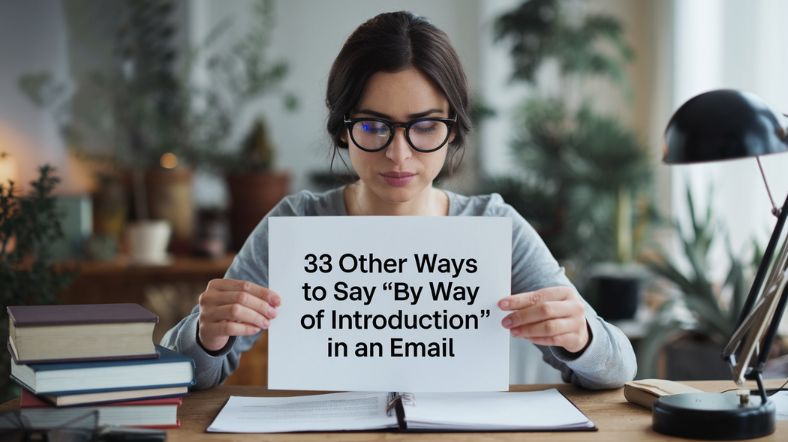When it comes to introducing someone or something in an email, the phrase “By way of introduction” can often feel overused or a bit stiff.
Finding fresh, engaging ways to make an introduction can elevate your communication, whether you’re reaching out for a business partnership, introducing a colleague, or simply starting a conversation.
In this article, we’ll explore 33 alternative phrases to say “by way of introduction,” each suitable for different contexts and tones.
Allow Me to Introduce
This phrase is a formal and polite way to introduce someone. It works well in business emails or when you want to show respect for the person being introduced. It’s often used in professional settings to ensure the recipient understands the significance of the introduction.
Example:
“Allow me to introduce Sarah, our new marketing director, who will be overseeing your account moving forward.”
Impact: Shows professionalism and respect for both parties.
Meet [Name]
Simple and straightforward, this phrase adds a personal touch to your email. It’s suitable for both professional and casual contexts, and it’s perfect when you’re introducing someone you know well.
Example:
“Meet John, who will be handling the logistics for your upcoming event.”
Impact: Makes the introduction feel friendly and informal.
I’d Like You to Know
This introduction phrase is ideal when you want to provide the recipient with relevant information. It’s a little more subtle, as it often precedes details about why you are introducing someone.
Example:
“I’d like you to know that Lisa, our finance manager, will be taking over this project.”
Impact: Creates a sense of informative importance.
Connecting You With
This phrase works well when you want to create a direct link between two people, especially in a business or networking context. It emphasizes the purpose of the introduction: facilitating a connection.
Example:
“I’m connecting you with James, our IT specialist, who can assist you with the technical aspects of your project.”
Impact: Highlights the purpose and utility of the connection.
A Quick Note About
If you’re introducing someone casually, or in a more laid-back email, this phrase works well. It’s informal and gives the recipient just enough context to understand the introduction.
Example:
“A quick note about Mike—he’s our lead designer and will be working closely with you on the creative side.”
Impact: Feels like a friendly heads-up, making the introduction approachable.
Let Me Present
This phrase is formal and polished, making it ideal for professional emails where you want to ensure the recipient understands the significance of the introduction.
Example:
“Let me present Dr. Thompson, a specialist in data analytics, who will be advising us on the project.”
Impact: Adds a sense of gravitas and formality to the introduction.
Here’s a Brief Intro
For situations where brevity is important, this phrase is perfect. It’s casual and works well in emails where you want to keep things to the point while still introducing someone.
Example:
“Here’s a brief intro to David, who will be managing your account moving forward.”
Impact: Keeps things light and concise, ideal for busy professionals.
I Want to Share
This phrase can be used when you’re excited to introduce someone and want to share relevant information. It conveys a sense of enthusiasm and eagerness.
Example:
“I want to share that Emma has joined our team as the new customer service lead. She’ll be in touch with you shortly.”
Impact: Feels personal and engaging, giving an enthusiastic introduction.
Say Hello to
This is a fun, friendly alternative that works well in casual settings or when you want the introduction to feel approachable and warm.
Example:
“Say hello to Sarah, who will be handling your account from now on.”
Impact: Casual and easygoing, great for building rapport.
Introducing You to
A classic phrase that can fit various settings, both formal and informal. It’s straightforward and communicates the main idea effectively.
Example:
“Introducing you to Ben, who will be the new point of contact for all your project needs.”
Impact: Direct and clear, making the purpose of the introduction clear.
Welcoming [Name]
This phrase emphasizes the welcoming nature of the introduction, often used when someone new is joining a team or taking on a new role. It shows positivity and excitement.
Example:
“Please join me in welcoming Rachel to the team. She’ll be overseeing the development of our new product line.”
Impact: Conveys warmth and enthusiasm, making the recipient feel welcomed.
A Friendly Introduction
This phrase softens the formality of introductions, making it perfect for building relationships in more casual or informal contexts.
Example:
“A friendly introduction to Mark, who’s been with the company for 10 years and is always happy to lend a hand.”
Impact: Makes the introduction feel warm and personal
By the Way of Introduction
This phrase maintains a formal yet approachable tone, perfect for business emails or professional introductions.
Example:
“By the way of introduction, I’d like to introduce Sarah, our new project manager.”
Impact: This variation keeps your introduction respectful while sounding more conversational.
As Way of Introduction
A bit more casual than the original phrase, this version works well for less formal emails.
Example:
“As way of introduction, this is John, who will be helping with your upcoming event.”
Impact: Slightly more laid-back, it softens the formality and feels approachable.
As a Way of Introduction
A subtle variation that strikes a balance between formal and casual. Ideal for emails where you want to introduce someone without being too rigid.
Example:
“As a way of introduction, I’m Laura, your new point of contact for the project.”
Impact: A versatile phrase that works well in both professional and casual settings.
By Way of Introduction Meaning
Using this phrase helps you clarify the intent behind the introduction. It’s great when you want to set the stage for more information.
Example:
“By way of introduction, I’d like to provide some background on our new initiative.”
Impact: Helps to transition into a more detailed explanation, enhancing the clarity of your message.
By Way of Introduction Email
When composing an email, this phrase is perfect for adding a formal touch, especially when you’re introducing someone or something important.
Example:
“By way of introduction, please allow me to introduce our new team leader, Mark.”
Impact: Professional and clear, this phrase communicates the introduction in an official manner.
By Way of Introduction in French
When writing an email in French, you might use “par manière d’introduction” to make a formal yet polite introduction.
Example:
“Par manière d’introduction, je vous présente notre nouvelle directrice.”
Impact: Adds a sophisticated touch for French-speaking recipients.
By Way of Introduction Deutsch
In German, you can use “zur Einführung” to introduce someone or something in a formal and respectful manner.
Example:
“Zur Einführung möchte ich Ihnen unser neues Teammitglied vorstellen.”
Impact: Effective for formal German business emails, this phrase communicates respect and professionalism.
By Way of Introduction en Français
Another French alternative, “en guise d’introduction,” is used to formally introduce someone or something in professional or polite contexts.
Example:
“En guise d’introduction, permettez-moi de vous présenter notre directeur commercial.”
Impact: Adds an air of sophistication and formality to your French-language emails.
By Way of Introduction Sample
Providing a sample when introducing a new concept or team member can help add value and clarity to your communication.
Example:
“By way of introduction, here’s a sample of the work our team has done with previous clients.”
Impact: It emphasizes the importance of the introduction and gives the recipient context.
By Way of Introduction in Spanish
For Spanish speakers, “a modo de introducción” is commonly used to introduce someone politely and respectfully.
Example:
“A modo de introducción, les presento a Laura, quien será su punto de contacto.”
Impact: It’s a formal yet warm introduction that works well in Spanish-speaking business environments.
By Way of Introduction in a Sentence
Incorporating the phrase “by way of introduction” into a full sentence helps to structure your email clearly and makes it sound professional.
Example:
“By way of introduction, my name is Sarah, and I look forward to working with you on the upcoming project.”
Impact: Makes the message feel more formal and approachable at the same time.
By Way of Introduction, My Name Is
When introducing yourself, this is a straightforward and polite way to establish your identity in an email.
Example:
“By way of introduction, my name is Peter, and I will be handling your account moving forward.”
Impact: Adds a professional tone and ensures the recipient knows who they are speaking to.
By Way of Introduction to Introduce Yourself
This phrase is especially useful when you’re introducing yourself in a formal setting, such as reaching out to a new client or colleague.
Example:
“By way of introduction to introduce myself, I am Jane, the project manager for your team.”
Impact: It’s a direct and professional way to give an introduction, especially when working with new contacts.
By Way of Introduction Email Example
When you want to provide an email sample for introducing someone or something, this phrase can help frame the context.
Example:
“By way of introduction email example, I’ve included Sarah’s contact details below for your convenience.”
Impact: It sets up expectations for the format or tone of your introduction, making the recipient feel more at ease.
By Way of Introduction, My Name Is Email
This variant is particularly useful for setting a professional tone in formal emails where you’re introducing yourself.
Example:
“By way of introduction, my name is Charles, and I am the new financial advisor for your company.”
Impact: A formal, clear way of introducing yourself in professional contexts.
By Way of Introduction to Introduce Someone Else
This phrase is great for introducing someone else while maintaining a formal, polished tone.
Example:
“By way of introduction, I’d like to introduce Emily, our senior developer, who will be overseeing the next phase of the project.”
Impact: Ensures clarity in the role of the person being introduced, making it easy for the recipient to understand who they are dealing with.
By Way of an Introduction
This subtle variation can be used interchangeably and is great when you want to add flexibility to your phrasing without changing the meaning.
Example:
“By way of introduction, or by way of an introduction, I am Mark, the new director of operations.”
Impact: Offers slight variation while retaining the meaning and professional tone.
By Means of Introduction
This alternative sounds a bit more formal and is often used in letters or emails that are particularly professional or business-focused.
Example:
“By means of introduction, I’d like to share that we have a new team member, Daniel, who will be joining our project next week.”
Impact: Adds formality and is suitable for high-level business communication.
Conclusion
Introducing someone effectively is all about tailoring your language to the situation and the relationship between you and the recipient.
Whether you’re in a formal business setting, a casual conversation, or a networking email, these 33 alternatives provide a wide range of options to suit any context.
From professional to friendly tones, using different phrases allows you to build stronger connections and engage your audience more naturally.
Don’t be afraid to experiment with these phrases in your emails! By adding variety to your introductions, you can enhance your communication and make your connections feel more personal and meaningful.

Mark Tony is a grammar expert with 5 years of experience, specializing in teaching English grammar, enhancing writing, reading, and speaking skills for diverse learners.









